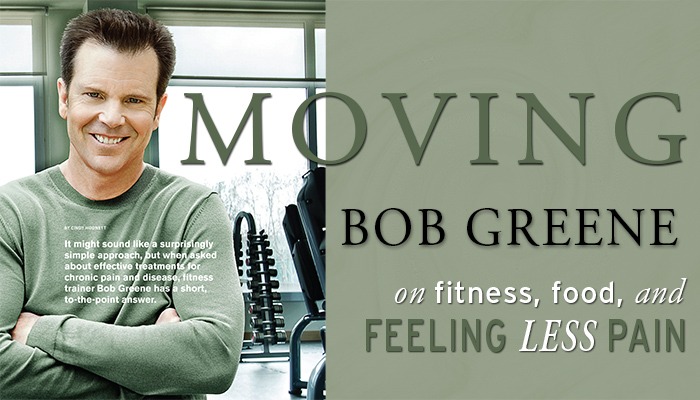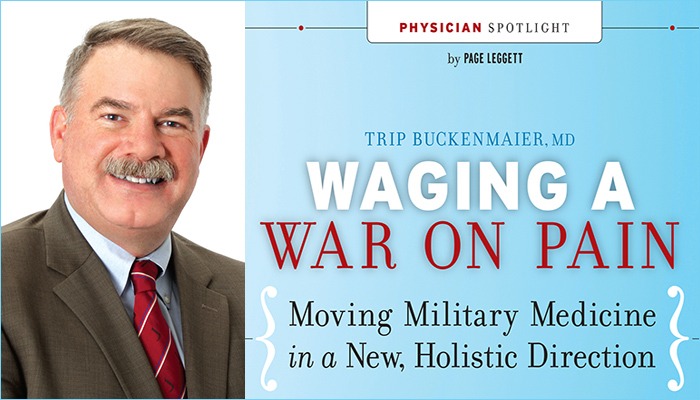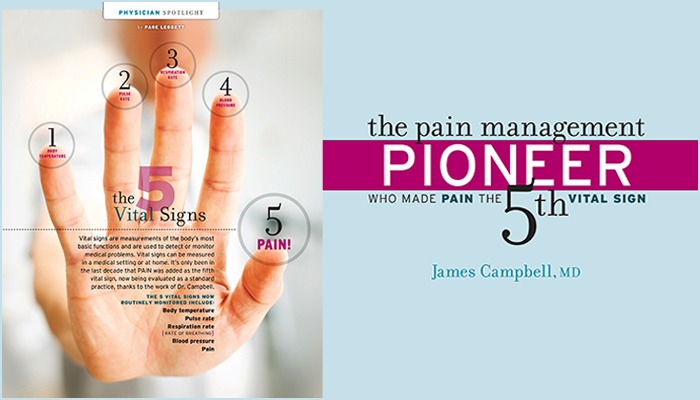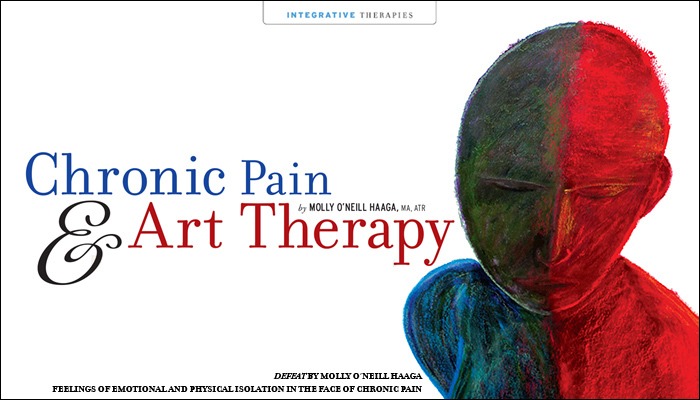Bob Greene

It might sound like a surprisingly simple approach, but when asked about effective treatments for chronic pain and disease, fitness trainer Bob Greene has a short, to-the-point answer:
“Moving”
Moving makes virtually everything better,” says Greene, an exercise physiologist, New York Times bestselling author, and frequent guest on The Oprah Winfrey Show. “If you are active, you are less prone to virtually every ailment. We were made to move, but as a society, we’ve stopped moving. We need to educate people about the importance of becoming more active.”
Greene’s first book, Make the Connection: Ten Steps to a Better Body—And a Better Life, debuted in 1996. Since that time, the amiable trainer has become one of America’s most visible proponents of a healthier American lifestyle, and millions of individuals have turned to Greene’s “Best Life” book series for guidance on nutrition, exercise, and optimal health.
The Best Life Guide to Managing Diabetes and Pre-Diabetes
Inspired in part by his parents’ battle with diabetes, Greene recently wrote The Best Life Guide to Managing Diabetes and Pre-Diabetes. Filled with practical advice on diet and fitness, the book also offers a variety of recipes unusual for a diabetic menu, including vanilla-peanut butter smoothies, cheesy cornbread, and slow-cooked pork. And while Greene always encourages his clients with diabetes to seek medical advice from a physician before beginning any new exercise or diet program, he is also excited about presenting a comprehensive and healthy approach to a disease that has reached epidemic levels in the American population.
“My parents are in their eighties, and they have had diabetes for a number of years,” Greene explains. “I also have extended family members affected by the disease, so I’ve always had an interest in the subject.
Through the years, I’ve geared my writings to everyone,” Greene continues. “But when I saw how this epidemic is affecting not just adults, but also children, in serious ways, I decided it was time to write this book.”
Greene co-authored The Best Life Guide to Managing Diabetes and Pre-Diabetes with noted physician John J. Merendino Jr., MD, and Janis Jibrin, MS, RD. Dietitians, diabetes educators, and physicians were asked to review the book before publication, and Greene says he was very pleased with their feedback.
“Everyone had the same comment,” he says. “They all talked about how complete the book is and liked the guidance offered by our three-phase program. For example, we don’t just talk about the importance of exercise, we offer a fitness plan. Our diet advice—including specific meal plans—is not only geared to taming blood sugar, but also to preventing heart disease and other complications of diabetes. We also have an entire chapter on diabetic drugs and how they are administered and what they do. I haven’t seen anything else that offers this type of one-stop-shopping approach, where everything about diabetes is covered in one book.”
Fitness and Pain
Greene is also part of an awareness campaign designed for people dealing with the challenges of osteoarthritis. Appropriately named the MOVE campaign, the educational effort includes a website that offers access to free exercise videos for OA patients, as well as commonsense advice about developing a fitness routine when pain is an issue.
“I’ve been doing this for almost 30 years, and I haven’t found a lot of people who love exercise,” Greene says. “With any condition that causes pain, the last thing people want to do is add the additional discomfort of exercise, and that is exactly what they should do.
“People can actually develop a tolerance for discomfort, and while I don’t ever want anyone to experience pain, as a trainer, I do have to push people into a discomfort zone,” Greene continues. “The human body repairs itself after exercise, and it sends messages to the brain that say, ‘Hey, I’ve gotta make myself a little bit more bullet-proof.’ Again, we were made to move, and everything from not having sidewalks in our communities and not having mandatory physical education in school in 48 states, to continuous hours spent watching television and/or on the computer, we’ve done everything we can to stop moving. A lot of people would rather make it about what drug can be taken to relieve pain or what food should be eaten to lose weight, but if you exercise, you are less prone to a variety of ailments. I’ve written books about eating and about exercise, and trust me, the eating books always sell more than the exercise books, but if we can appreciate what exercise does for the body, we’ll be on the right track.”
Fitness and Medicine
Many patients with chronic pain often find themselves on the receiving end of a long list of medications. As with the physical manifestations of many diseases, Greene states that a fitness program can also often help an individual reduce the amount of medication needed to treat a condition.
“We’re such a medicated society,” he says. “However, when we take someone who is not active and get them active, nine times out of ten, the medications are at least reduced. Diabetes is a classic example. I always push people back to their physicians to make that decision, but if medication can be reduced, it’s a great option.”
Kids and Getting Fit with Wii
Greene is a new father with a three-year-old daughter and six-month-old son, and while they live a very active lifestyle, Greene recognizes that the lure of technology will impact his own children in years to come. With that in mind, he collaborated along with other fitness experts on EA Sports Active, an innovative line of interactive fitness products for the Wii gaming system, and he acknowledges the “if you can’t beat ’em, join ’em” connotation.
“My children are still young, but I look at older kids, and they’re not moving either,” Greene explains. “It’s not like when I grew up and we walked to school, had P.E. every day, and then came home and played outside until dinner. It’s a very different lifestyle today, and I didn’t want to be one of those parents who say, ‘Back in my day….’ Instead, I decided to see the wonderful side of technology and how it could be used to help children and families. We’re not going to take away the Wii or the Game Boy, so why not use them as a powerful tool? It’s all about finding creative ways to be active, and this product is great for both kids and families.”
Greene’s Most Famous Client
Most people know about Greene’s longstanding friendship with media personality Oprah Winfrey. For years, Winfrey’s personal battles with weight have been the subject of much discussion on her talk show, and Greene says that he thinks people identify with the superstar’s health challenges because she is open and honest about her experiences with the same types of issues many people face in their own lives.
“One of the most recent things Oprah has dealt with is a thyroid condition,” Greene says. “The doctors weren’t able to provide concrete answers for almost a year, and so Oprah was told to cool it on the workouts for a while. Well, when you take someone who publicly says they hate exercise and you tell them to stop exercising, they’re going to take you up on it.
“Now that we have answers, she’s back on the horse again, and she’s committed to exercising every day,” says Greene. “And even though she has some problems with her knees and pain, she realizes that moving relieves everything.
“Another client of mine is on the cover of my Total Body Makeover DVD. She lost 160 pounds, and this year, she just completed her 100th marathon. She has become extremely active, and it’s a different life for her, and that’s the point I like to emphasize with my clients. Exercise doesn’t just enhance a life; in many cases, it drastically changes a life.”
Relationships and Fitness
Obesity is one of the top American health problems in the 21st century, and Greene says that until lifestyle habits are addressed, the number of overweight adults and children will continue to rise. In addition to the need for activity on a daily basis, Greene advises people to look at their diet and explore its connection to the overall quality of their lives.
“The first step is figuring out what kind of life you want to have,” he says. “So many people have an unhealthy relationship with food, and part of that is because they don’t take the time to decide what is important in their lives. I always have my clients do a circle-of-life exercise where they draw a pie and divide it into sections. In each section, they list what is most important to them, and I’m shocked to find that a lot of people don’t ask themselves what is important.”
For the pie exercise, Greene encourages his clients to think about areas of their lives like relationships, spirituality, careers, and even finances. He sees all of the various portions of the pie as part of complete life awareness, and he ties this awareness to fitness in several ways.
“This is where I spend all of my time with clients because when things aren’t going well with your relationships or your finances, that’s when you ignore yourself and run to the refrigerator and eat unhealthy foods,” Greene explains. “We’re all fed by one or two of the areas of the pie, and something else on the list suffers while we’re in pursuit of what we think is important. So weekly, at the very least, people need to think about which parts of their lives aren’t going well and what they can do to improve things. I try to educate people that you don’t improve everything overnight, but you take small steps to improve things—for example, you just lace up your sneakers and take a walk or pick up the phone and call a friend.”
Greene realizes that many people are overwhelmed at the thought of making drastic changes in their lives, whether the changes involve reestablishing important relationships or a diet makeover. He says that the secret lies in recognizing the importance of each small change and continuing to build on it in other areas.“
Life is what is achieved through the collective choices we make,” Greene says. “We create our lives by making these choices, and if we wake up each day and ask ourselves how we can get a little bit closer to our perfect life, then at the end of a year, we will have a different life.”
Bob Greene’s Tips on Eating Healthy During Challenging Economic Times
Food is a major expense in many households, but one of America’s most popular fitness trainers says that there are ways to eat healthily and also save money. He recommends that people shop the perimeter of the grocery store, stocking up on fresh fruits and vegetables on sale that week and avoiding processed foods, and Greene adds that healthy choices save money in other areas.
“The foods that offer the most bang for the buck are vegetables,” Greene says. “They are the most nutritionally packed items you can consume. Frozen vegetables are usually less expensive and often just as nutritious. Fruits are also incredibly nutrient-packed; vary your picks and you’ll get a wider range of nutrients. Again, frozen is fine.
“Look for high-quality protein that is not attached to high amounts of saturated fats and include cold-water fish like salmon, mackerel and sardines, which are high in omega-3 fats and good for the heart and the brain. Canned salmon is a good low-cost alternative, and the bone-in type is also a great source of calcium,” he continues. “Nuts should also be on your shopping list—they make an excellent snack and are rich in healthy fats. I also think that most people benefit from a calcium and vitamin D supplement.
“I heard recently that 95 percent of people have some weight they want to lose, so with that in mind, you can probably say that a majority of people are eating too many calories,” Greene concludes. “The simple act of cutting 10 to 15 percent of your total calories represents a savings because you are eating less and probably not purchasing as many empty calories, like the ones you get with soda or white bread. Substitute the convenience foods with fresh fruits and vegetables, and you’ll save money not only on food but also on the medical expenses that often accompany being overweight. None of this is new; it’s the same boring stuff we’ve heard for 30 years that have been ignored, but it really is the way we should be eating.”
PainPathways Magazine
PainPathways is the first, only and ultimate pain magazine. First published in spring 2008, PainPathways is the culmination of the vision of Richard L. Rauck, MD, to provide a shared resource for people living with and caring for others in pain. This quarterly resource not only provides in-depth information on current treatments, therapies and research studies but also connects people who live with pain, both personally and professionally.
View All By PainPathways






